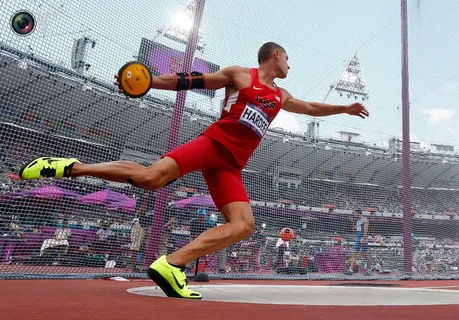Flying Discs - Discus Throwing

Dysk throwing is a discipline in athletics, consisting in throwing a special sports projectile - a discus at a distance. It belongs to throwing and is included in the technical types of athletics program. Requires strength and coordination of movements from athletes. It is the Olympic discipline of athletics for men since 1896, for women since 1928. He is a member of the all-around athletics.
Competitions and rules
Competitors perform a throw from a circle with a diameter of 2500 mm. Throwing range is measured as the distance from the outer circle of this circle to the point of impact of the projectile. The weight of the disc in men is 2 kg, in juniors 1.75 kg, in boys 1.5 kg. In women, juniors and girls - 1 kg. The diameter of the disc is 219-221 mm for men and 180-182 mm for women.
In official IAAF competitions, athletes make six attempts. If there are more than eight participants, then after the first 3 attempts, the top eight are selected, which in the next three attempts determine the winner by the maximum result in six attempts.
Discus throwing is performed from a sector fenced with a grid with a permitted horizontal angle of departure of not more than 35 ° (more precisely, 34.92 °), otherwise the disk will not be able to fly into the field and will crash into the net or supports. The width of the disc departure gate is 6 m. It is forbidden for the athlete to go beyond the sector until the disk lands. It is allowed to touch the sector fence with a disk, if other rules are not violated.
Discus throwing in ancient Greece
Discus throwing is a very ancient sport. In the V century BC. e. sculptor Myron made a sculpture of a discobolus (Diskobolos), which is now world famous. The ancient Greek gods also played with the disc. According to one of the myths, Apollo competed in discus throwing with his beloved, Prince Hyacinth of Sparta. To impress, Apollo threw the disc with all his might. Hyacinth, for his part, wanted to impress Apollo and tried to catch the disk. The disc hit Hyacinth and he died. According to another legend, the jealous god of the west winds, Zephyr, blew into the disk to destroy Hyacinth.
As historians' research and archaeological excavations show, discus throwing was popular in ancient Greece, and these competitions took place at the ancient Olympic Games. The shells were made of stone and bronze, weighing from 1.25 to 5.70 kg, with a diameter of 16.5 to 34 cm. As far as can be judged from the historical evidence of that time, athletes threw from an elevation, with a lateral movement, when the plane of the disk was perpendicular to the ground.
- Arts
- Business
- Computers
- Игры
- Health
- Главная
- Kids and Teens
- Деньги
- News
- Recreation
- Reference
- Regional
- Science
- Shopping
- Society
- Sports
- Бизнес
- Деньги
- Дом
- Досуг
- Здоровье
- Игры
- Искусство
- Источники информации
- Компьютеры
- Наука
- Новости и СМИ
- Общество
- Покупки
- Спорт
- Страны и регионы
- World


